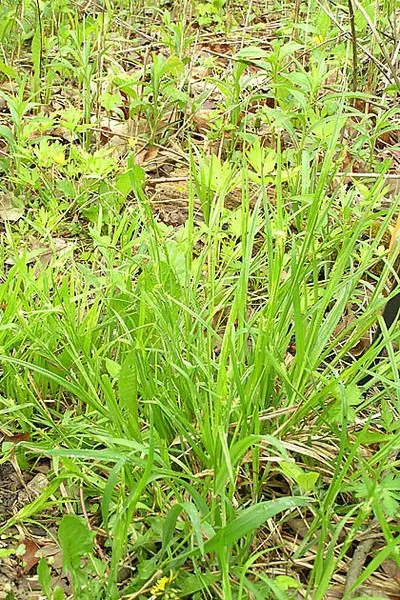
Author: Dewey
Bibliography: Amer. J. Sci. Arts 10: 45 (1826)
Year: 1826
Status: accepted
Rank: species
Genus: Carex
Vegetable: False
Observations: SE. Canada to C. & E. U.S.A.
The Eastern woodland sedge, known scientifically as Carex blanda, is a perennial plant species belonging to the Cyperaceae family. First described by Dewey in the American Journal of Science and Arts in 1826, this grass-like plant is native to southeastern Canada and extends through central and eastern regions of the United States.
As a versatile and resilient species, Carex blanda thrives in a variety of habitats including woodlands, meadows, and the shaded understories of forests. Its adaptability to different environmental conditions makes it a valuable component of the native flora in these regions.
The Eastern woodland sedge typically forms dense clumps of narrow, arching leaves that can reach a height of about 30-50 cm. The foliage provides excellent ground cover, helping to control soil erosion and creating a conducive environment for other plant species to establish. During the blooming season, the plant produces small, inconspicuous flowers that are typical of the sedge family, contributing to the biodiversity and ecological balance of its native habitat.
This sedge is not only important ecologically but also offers aesthetic and practical value for landscaping, particularly in naturalized garden settings and restoration projects. Its low-maintenance nature and ability to thrive in shaded areas make it a popular choice for sustainable gardening practices.
In summary, Carex blanda, the Eastern woodland sedge, is a key species within the Cyperaceae family, contributing significantly to the ecosystems of southeastern Canada and central to eastern U.S.A. Its ecological versatility and low-maintenance characteristics make it an indispensable plant for both natural landscapes and managed garden spaces.
Eng: eastern woodland sedge, woodland sedge, bland sedge, common woodland sedge
Fra: carex lisse
En: Eastern woodland sedge, BLAND SEDGE, Woodland sedge, Common woodland sedge
Fr: Carex lisse
Taken Jan 1, 1900 by EOL − John Hilty (cc-by-nc)
Taken Aug 12, 2010 by EOL − Kirchner, Natalie (cc-by-nc-sa)
Taken Aug 12, 2010 by EOL − Kirchner, Natalie (cc-by-nc-sa)
Taken Aug 12, 2010 by EOL − Kirchner, Natalie (cc-by-nc-sa)
Taken May 26, 2019 by Dan Hribar (cc-by-sa)
Taken Jan 1, 1900 by EOL − John Hilty (cc-by-nc)
Taken Jun 7, 2020 by Jodi Marr (cc-by-sa)
Taken Jan 1, 1900 by EOL − John Hilty (cc-by-nc)
Taken Aug 12, 2010 by EOL − Kirchner, Natalie (cc-by-nc-sa)
Taken Jan 6, 2022 by Riley Korte (cc-by-sa)
Taken Aug 12, 2010 by EOL − Kirchner, Natalie (cc-by-nc-sa)
Taken Aug 12, 2010 by EOL − Kirchner, Natalie (cc-by-nc-sa)
Taken Jun 4, 2008 by EOL − Chicago Botanic Garden 2008 (cc-by-nc-sa)
© copyright of the Board of Trustees of the Royal Botanic Gardens, Kew.
© copyright of the Board of Trustees of the Royal Botanic Gardens, Kew.
© copyright of the Board of Trustees of the Royal Botanic Gardens, Kew.
Growth form: Bunch
Growth habit: Graminoid
Growth rate: Slow
Ph maximum: 7.0
Ph minimum: 4.4
Family: Myrtaceae Author: (F.Muell.) K.D.Hill & L.A.S.Johnson Bibliography: Telopea 6: 402 (1995) Year: 1995 Status:…
Family: Rubiaceae Author: Pierre ex A.Froehner Bibliography: Notizbl. Bot. Gart. Berlin-Dahlem 1: 237 (1897) Year:…
Family: Sapindaceae Author: Koidz. Bibliography: J. Coll. Sci. Imp. Univ. Tokyo 32(1): 38 (1911) Year:…
Family: Asteraceae Author: A.Gray Bibliography: Pacif. Railr. Rep.: 107 (1857) Year: 1857 Status: accepted Rank:…
Family: Fabaceae Author: Medik. Bibliography: Vorles. Churpfälz. Phys.-Ökon. Ges. 2: 398 (1787) Year: 1787 Status:…
Family: Aspleniaceae Author: (Cav.) Alston Bibliography: Bull. Misc. Inform. Kew 1932: 309 (1932) Year: 1932…